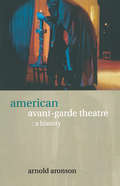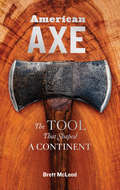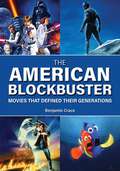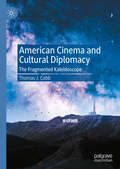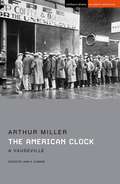- Table View
- List View
American Art in Asia: Artistic Praxis and Theoretical Divergence (Routledge Research in Art History)
by Michelle Lim Kyunghee PyunThis book challenges existing notions of what is "American" and/or "Asian" art, moving beyond the identity issues that have dominated art-world conversations of the 1980s and the 1990s and aligning with new trends and issues in contemporary art today, e.g. the Global South, labor, environment, and gender identity. Contributors examine both historical and contemporary instances in art practices and exhibition-making under the rubric of "American art in Asia." The book complicates existing notions of what constitutes American art, Asian American (and American Asian) art. As today’s production and display of contemporary art takes place across diffused borders, under the fluid conditions of a globalized art world since transformed by the COVID-19 pandemic, new contexts and art historical narratives are forming that upend traditional Euro-American mappings of center-margins, migratory patterns and community engagement. The book will be of interest to scholars working in art history, American studies, Asian studies and visual culture.
American Artists Engage the Built Environment, 1960-1979 (Routledge Research in Art History)
by Susanneh BieberThis volume reframes the development of US-American avant-garde art of the long 1960s—from minimal and pop art to land art, conceptual art, site-specific practices, and feminist art—in the context of contemporary architectural discourses. Susanneh Bieber analyzes the work of seven major artists, Donald Judd, Robert Grosvenor, Claes Oldenburg, Robert Smithson, Lawrence Weiner, Gordon Matta-Clark, and Mary Miss, who were closely associated with the formal-aesthetic innovations of the period. While these individual artists came to represent diverse movements, Bieber argues that all of them were attracted to the field of architecture—the work of architects, engineers, preservationists, landscape designers, and urban planners—because they believed these practices more directly shaped the social and material spaces of everyday life. This book’s contribution to the field of art history is thus twofold. First, it shows that the avant-garde of the long 1960s did not simply develop according to an internal logic of art but also as part of broader sociocultural discourses about buildings and cities. Second, it exemplifies a methodological synthesis between social art history and poststructural formalism that is foundational to understanding the role of art in the construction of a more just and egalitarian society. The book will be of interest to scholars working in art history, architecture, urbanism, and environmental humanism.
American Artists Engage the Built Environment, 1960-1979 (Routledge Research in Art History)
by Susanneh BieberThis volume reframes the development of US-American avant-garde art of the long 1960s—from minimal and pop art to land art, conceptual art, site-specific practices, and feminist art—in the context of contemporary architectural discourses. Susanneh Bieber analyzes the work of seven major artists, Donald Judd, Robert Grosvenor, Claes Oldenburg, Robert Smithson, Lawrence Weiner, Gordon Matta-Clark, and Mary Miss, who were closely associated with the formal-aesthetic innovations of the period. While these individual artists came to represent diverse movements, Bieber argues that all of them were attracted to the field of architecture—the work of architects, engineers, preservationists, landscape designers, and urban planners—because they believed these practices more directly shaped the social and material spaces of everyday life. This book’s contribution to the field of art history is thus twofold. First, it shows that the avant-garde of the long 1960s did not simply develop according to an internal logic of art but also as part of broader sociocultural discourses about buildings and cities. Second, it exemplifies a methodological synthesis between social art history and poststructural formalism that is foundational to understanding the role of art in the construction of a more just and egalitarian society. The book will be of interest to scholars working in art history, architecture, urbanism, and environmental humanism.
American Artists On Art: From 1940 to 1980 (PDF)
by ElIen H. JohnsonFrom the Preface: The fact that so much of modern art has devoted itself to the exploration and assertion of its own identity is reflected in, but does not explain, the increasing amount of writing and talking on the part of contemporary artists. Rather, the whole history of the changing role of art and artists in a democratic, industrial, and technological society stands behind the spate of artists' words and the public's hunger for them--even some of the general public out there beyond art's little circle. Statements by artists appeal somewhat the way drawings do: they bring us, or at least they hold the promise of bringing us, closer to the artist's thoughts and feelings and to an understanding of his or her modus operandi; they hold the keys to a mysterious realm. And sometimes they offer us the sheer pleasure of good reading. Such is the primary raison d'etre of this book.Its other motivation is educational, and stems from the frustrating lack, in teaching contemporary art, of any single compilation of statements by American artists from 1940 to the present.... This anthology differs in several respects from those others that do include documents of American art since 1940.... The selection I have made is devoted exclusively to statements of artists; it is limited to the last four decades; it presents in a single volume a representative and fairly comprehensive coverage of major developments in American art beginning with Abstract Expressionism; and, whenever possible, it cities the first, or among the very earliest, documents signalizing a shift in the definition, intent, or direction of art."
American Artists On Art: From 1940 To 1980
by Sherron SparksFrom the Preface: The fact that so much of modern art has devoted itself to the exploration and assertion of its own identity is reflected in, but does not explain, the increasing amount of writing and talking on the part of contemporary artists. Rather, the whole history of the changing role of art and artists in a democratic, industrial, and technological society stands behind the spate of artists' words and the public's hunger for them--even some of the general public out there beyond art's little circle. Statements by artists appeal somewhat the way drawings do: they bring us, or at least they hold the promise of bringing us, closer to the artist's thoughts and feelings and to an understanding of his or her modus operandi; they hold the keys to a mysterious realm. And sometimes they offer us the sheer pleasure of good reading. Such is the primary raison d'etre of this book.Its other motivation is educational, and stems from the frustrating lack, in teaching contemporary art, of any single compilation of statements by American artists from 1940 to the present.... This anthology differs in several respects from those others that do include documents of American art since 1940.... The selection I have made is devoted exclusively to statements of artists; it is limited to the last four decades; it presents in a single volume a representative and fairly comprehensive coverage of major developments in American art beginning with Abstract Expressionism; and, whenever possible, it cities the first, or among the very earliest, documents signalizing a shift in the definition, intent, or direction of art."
American Aurora: Environment and Apocalypse in the Life of Johannes Kelpius (Oxford Studies in Western Esotericism)
by Timothy Grieve-CarlsonAmerican Aurora explores the impact of climate change on early modern radical religious groups during the height of the Little Ice Age in the seventeenth century. Focusing on the life and legacy of Johannes Kelpius (1667-1707), an enormously influential but comprehensively misunderstood theologian who settled outside of Philadelphia from 1604 to 1707, Timothy Grieve-Carlson explores the Hermetic and alchemical dimensions of Kelpius's Christianity before turning to his legacy in American religion and literature. This engaging analysis showcases Kelpius's forgotten theological intricacies, spiritual revelations, and cosmic observations, illuminating the complexity and foresight of an important colonial mystic. As radical Protestants during Kelpius's lifetime struggled to understand their changing climate and a seemingly eschatological cosmos, esoteric texts became crucial sources of meaning. Grieve-Carlson presents original translations of Kelpius's university writings, which have never been published in English, along with analyses and translations of other important sources from the period in German and Latin. Ultimately, American Aurora points toward a time and place when climate change caused an eruption of esoteric thought and practice-and how this moment has been largely forgotten.
American Aurora: Environment and Apocalypse in the Life of Johannes Kelpius (Oxford Studies in Western Esotericism)
by Timothy Grieve-CarlsonAmerican Aurora explores the impact of climate change on early modern radical religious groups during the height of the Little Ice Age in the seventeenth century. Focusing on the life and legacy of Johannes Kelpius (1667-1707), an enormously influential but comprehensively misunderstood theologian who settled outside of Philadelphia from 1604 to 1707, Timothy Grieve-Carlson explores the Hermetic and alchemical dimensions of Kelpius's Christianity before turning to his legacy in American religion and literature. This engaging analysis showcases Kelpius's forgotten theological intricacies, spiritual revelations, and cosmic observations, illuminating the complexity and foresight of an important colonial mystic. As radical Protestants during Kelpius's lifetime struggled to understand their changing climate and a seemingly eschatological cosmos, esoteric texts became crucial sources of meaning. Grieve-Carlson presents original translations of Kelpius's university writings, which have never been published in English, along with analyses and translations of other important sources from the period in German and Latin. Ultimately, American Aurora points toward a time and place when climate change caused an eruption of esoteric thought and practice-and how this moment has been largely forgotten.
AMERICAN AVANT-GARDE C
by Rebecca A. SheehanCan films philosophize rather than simply represent philosophical ideas developed outside of the cinematic medium? Taking up this crucial question for the emergent field of film philosophy, American Avant-Garde Cinema's Philosophy of the In-Between argues that the films of the American avant-garde do in fact do philosophy and illuminates the ethical stakes of their aesthetic interventions. Author Rebecca A. Sheehan contends that American avant-garde cinema's characteristic self-reflexivity is an interrogation of the modes and stakes of our engagement with the world on and beyond the screen. The book demonstrates this with the theory of the in-between: a pervasive figure that helps clarify how avant-garde cinema's reflections on the creation of images construct an ethics of perception itself, a responsibility to perpetuate thought in an enduring re-encounter with the world and with meaning's unfinished production. The book is structured by a taxonomy of the multiple in-betweens evident in American avant-garde filmmaking. Rather than systematically seeking reproductions of particular philosophers' ideas in avant-garde films, Sheehan derives categories of analysis and the philosophical claims they disclose from close readings of the films themselves. This methodology opposes mapping preconfigured philosophical concepts and values onto these films, as too many philosophical approaches to cinema have done, silencing the philosophies uniquely articulated by these films in the interest of making them ventriloquize philosophies advanced elsewhere. The chapters of this book trace three modes of the in-between that function philosophically in American avant-garde cinema: the material, the dimensional, and the conceptual. Although the chapters are organized around discrete aesthetic and philosophical preoccupations that unify several filmmakers, these three presentations of the in-between cut through all the chapters, allowing the subjects of each to converse over the course of the book.
American Avant-Garde Cinema's Philosophy of the In-Between
by Rebecca A. SheehanCan films philosophize rather than simply represent philosophical ideas developed outside of the cinematic medium? Taking up this crucial question for the emergent field of film philosophy, American Avant-Garde Cinema's Philosophy of the In-Between argues that the films of the American avant-garde do in fact do philosophy and illuminates the ethical stakes of their aesthetic interventions. Author Rebecca A. Sheehan contends that American avant-garde cinema's characteristic self-reflexivity is an interrogation of the modes and stakes of our engagement with the world on and beyond the screen. The book demonstrates this with the theory of the in-between: a pervasive figure that helps clarify how avant-garde cinema's reflections on the creation of images construct an ethics of perception itself, a responsibility to perpetuate thought in an enduring re-encounter with the world and with meaning's unfinished production. The book is structured by a taxonomy of the multiple in-betweens evident in American avant-garde filmmaking. Rather than systematically seeking reproductions of particular philosophers' ideas in avant-garde films, Sheehan derives categories of analysis and the philosophical claims they disclose from close readings of the films themselves. This methodology opposes mapping preconfigured philosophical concepts and values onto these films, as too many philosophical approaches to cinema have done, silencing the philosophies uniquely articulated by these films in the interest of making them ventriloquize philosophies advanced elsewhere. The chapters of this book trace three modes of the in-between that function philosophically in American avant-garde cinema: the material, the dimensional, and the conceptual. Although the chapters are organized around discrete aesthetic and philosophical preoccupations that unify several filmmakers, these three presentations of the in-between cut through all the chapters, allowing the subjects of each to converse over the course of the book.
American Avant-Garde Theatre: A History (Theatre Production Studies)
by Arnold AronsonThis stunning contribution to the field of theatre history is the first in-depth look at avant-garde theatre in the United States from the early 1950s to the 1990s. American Avant-Garde Theatre offers a definition of the avant-garde, and looks at its origins and theoretical foundations by examining: *Gertrude Stein *John Cage *The Beat writers *Avant-garde cinema *Abstract Expressionism *Minimalism There are fascinating discussions and illustrations of the productions of the Living Theatre, the Wooster Group, Open Theatre, Ontological-Hysteric Theatre and Performance Group. among many others. Aronson also examines why avant-garde theatre declined and virtually disappeared at the end of the twentieth century.
American Avant-Garde Theatre: A History (Theatre Production Studies)
by Arnold AronsonThis stunning contribution to the field of theatre history is the first in-depth look at avant-garde theatre in the United States from the early 1950s to the 1990s. American Avant-Garde Theatre offers a definition of the avant-garde, and looks at its origins and theoretical foundations by examining: *Gertrude Stein *John Cage *The Beat writers *Avant-garde cinema *Abstract Expressionism *Minimalism There are fascinating discussions and illustrations of the productions of the Living Theatre, the Wooster Group, Open Theatre, Ontological-Hysteric Theatre and Performance Group. among many others. Aronson also examines why avant-garde theatre declined and virtually disappeared at the end of the twentieth century.
American Axe: The Tool That Shaped a Continent
by Brett McLeodWoodsman and forester Brett McLeod pays tribute to the axe with stunning photography and illuminating text that traces this historic hand tool&’s evolution in form and function through North American culture and history.
American Beauty Shop (Modern Plays)
by Dana Lynn FormbyWhen that baby's born . . . your life ceases being your life. That child owns every single one of your actions. Every breath of your body. Every dream that you ever had, Mrs. Top Two Percent, those dreams are sucked out of you and poured into the soul of that child.It's hard to pull yourself up by your bootstraps in this economy-Sue should know. It's harder when you've got kids, even whip-smart, talented ones like Judy. Sue has big dreams for both her basement beauty shop and her daughter, who's anxiously waiting for a letter from Berkeley that could change her life. Armed with tough love, combative humor and an uncompromising work ethic, Sue is struggling to balance her own livelihood and Judy's future. A heartfelt play about the true cost of dreams.American Beauty Shop received its world premiere at Chicago Dramatists in April 2016, having received readings at Steppenwolf, Florida Studio Theatre, Steep Theatre, Illinois Shakespeare Festival and Chicago Dramatists.
American Beauty Shop (Modern Plays)
by Dana Lynn FormbyWhen that baby's born . . . your life ceases being your life. That child owns every single one of your actions. Every breath of your body. Every dream that you ever had, Mrs. Top Two Percent, those dreams are sucked out of you and poured into the soul of that child.It's hard to pull yourself up by your bootstraps in this economy-Sue should know. It's harder when you've got kids, even whip-smart, talented ones like Judy. Sue has big dreams for both her basement beauty shop and her daughter, who's anxiously waiting for a letter from Berkeley that could change her life. Armed with tough love, combative humor and an uncompromising work ethic, Sue is struggling to balance her own livelihood and Judy's future. A heartfelt play about the true cost of dreams.American Beauty Shop received its world premiere at Chicago Dramatists in April 2016, having received readings at Steppenwolf, Florida Studio Theatre, Steep Theatre, Illinois Shakespeare Festival and Chicago Dramatists.
The American Blockbuster: Movies That Defined Their Generations
by Benjamin CraceProviding an indispensable resource for students and general readers, this book serves as an entry point for a conversation on America's favorite pastime, focusing in on generational differences and the evolution of American identity.In an age marked by tension and division, Americans of all ages and backgrounds have turned to film to escape the pressures of everyday life. Yet, beyond escapism, popular cinema is both a mirror and microscope for our collective psyche. Examining the films that have made billions of dollars through a new lens reveals that popular culture is a vital source for understanding what it means to be an American.This book is divided into four sections, each associated with a different generation. Featuring such era-defining hits as Jaws, Back to the Future, Avatar, and The Avengers, each section presents detailed film analyses that showcase the consistency of certain American values throughout generations as well as the constant renegotiation of others. Ideal for any cinephile, The American Blockbuster demonstrates how complex and meaningful even the summer blockbuster can be.
The American Blockbuster: Movies That Defined Their Generations
by Benjamin CraceProviding an indispensable resource for students and general readers, this book serves as an entry point for a conversation on America's favorite pastime, focusing in on generational differences and the evolution of American identity.In an age marked by tension and division, Americans of all ages and backgrounds have turned to film to escape the pressures of everyday life. Yet, beyond escapism, popular cinema is both a mirror and microscope for our collective psyche. Examining the films that have made billions of dollars through a new lens reveals that popular culture is a vital source for understanding what it means to be an American.This book is divided into four sections, each associated with a different generation. Featuring such era-defining hits as Jaws, Back to the Future, Avatar, and The Avengers, each section presents detailed film analyses that showcase the consistency of certain American values throughout generations as well as the constant renegotiation of others. Ideal for any cinephile, The American Blockbuster demonstrates how complex and meaningful even the summer blockbuster can be.
American Catholics and the Church of Tomorrow: Building Churches for the Future, 1925–1975
by Catherine R. OsborneIn the mid-twentieth century, American Catholic churches began to shed the ubiquitous spires, stained glass, and gargoyles of their European forebears, turning instead toward startling and more angular structures of steel, plate glass, and concrete. But how did an institution like the Catholic Church, so often seen as steeped in inflexible traditions, come to welcome this modernist trend? Catherine R. Osborne’s innovative new book finds the answer: the alignment between postwar advancements in technology and design and evolutionary thought within the burgeoning American Catholic community. A new, visibly contemporary approach to design, church leaders thought, could lead to the rebirth of the church community of the future. As Osborne explains, the engineering breakthroughs that made modernist churches feasible themselves raised questions that were, for many Catholics, fundamentally theological. Couldn’t technological improvements engender worship spaces that better reflected God's presence in the contemporary world? Detailing the social, architectural, and theological movements that made modern churches possible, American Catholics and the Churches of Tomorrow breaks important new ground in the history of American Catholicism, and also presents new lines of thought for scholars attracted to modern architectural and urban history.
American Catholics and the Church of Tomorrow: Building Churches for the Future, 1925–1975
by Catherine R. OsborneIn the mid-twentieth century, American Catholic churches began to shed the ubiquitous spires, stained glass, and gargoyles of their European forebears, turning instead toward startling and more angular structures of steel, plate glass, and concrete. But how did an institution like the Catholic Church, so often seen as steeped in inflexible traditions, come to welcome this modernist trend? Catherine R. Osborne’s innovative new book finds the answer: the alignment between postwar advancements in technology and design and evolutionary thought within the burgeoning American Catholic community. A new, visibly contemporary approach to design, church leaders thought, could lead to the rebirth of the church community of the future. As Osborne explains, the engineering breakthroughs that made modernist churches feasible themselves raised questions that were, for many Catholics, fundamentally theological. Couldn’t technological improvements engender worship spaces that better reflected God's presence in the contemporary world? Detailing the social, architectural, and theological movements that made modern churches possible, American Catholics and the Churches of Tomorrow breaks important new ground in the history of American Catholicism, and also presents new lines of thought for scholars attracted to modern architectural and urban history.
American Catholics and the Church of Tomorrow: Building Churches for the Future, 1925–1975
by Catherine R. OsborneIn the mid-twentieth century, American Catholic churches began to shed the ubiquitous spires, stained glass, and gargoyles of their European forebears, turning instead toward startling and more angular structures of steel, plate glass, and concrete. But how did an institution like the Catholic Church, so often seen as steeped in inflexible traditions, come to welcome this modernist trend? Catherine R. Osborne’s innovative new book finds the answer: the alignment between postwar advancements in technology and design and evolutionary thought within the burgeoning American Catholic community. A new, visibly contemporary approach to design, church leaders thought, could lead to the rebirth of the church community of the future. As Osborne explains, the engineering breakthroughs that made modernist churches feasible themselves raised questions that were, for many Catholics, fundamentally theological. Couldn’t technological improvements engender worship spaces that better reflected God's presence in the contemporary world? Detailing the social, architectural, and theological movements that made modern churches possible, American Catholics and the Churches of Tomorrow breaks important new ground in the history of American Catholicism, and also presents new lines of thought for scholars attracted to modern architectural and urban history.
American Catholics and the Church of Tomorrow: Building Churches for the Future, 1925–1975
by Catherine R. OsborneIn the mid-twentieth century, American Catholic churches began to shed the ubiquitous spires, stained glass, and gargoyles of their European forebears, turning instead toward startling and more angular structures of steel, plate glass, and concrete. But how did an institution like the Catholic Church, so often seen as steeped in inflexible traditions, come to welcome this modernist trend? Catherine R. Osborne’s innovative new book finds the answer: the alignment between postwar advancements in technology and design and evolutionary thought within the burgeoning American Catholic community. A new, visibly contemporary approach to design, church leaders thought, could lead to the rebirth of the church community of the future. As Osborne explains, the engineering breakthroughs that made modernist churches feasible themselves raised questions that were, for many Catholics, fundamentally theological. Couldn’t technological improvements engender worship spaces that better reflected God's presence in the contemporary world? Detailing the social, architectural, and theological movements that made modern churches possible, American Catholics and the Churches of Tomorrow breaks important new ground in the history of American Catholicism, and also presents new lines of thought for scholars attracted to modern architectural and urban history.
American Cinema and Cultural Diplomacy: The Fragmented Kaleidoscope
by Thomas J. CobbThis book contends that Hollywood films help illuminate the incongruities of various periods in American diplomacy. From the war film Bataan to the Revisionist Western The Wild Bunch, cinema has long reflected US foreign policy’s divisiveness both directly and allegorically. Beginning with the 1990s presidential drama The American President and concluding with Joker’s allegorical treatment of the Trump era, this book posits that the paradigms for political reflection are shifting in American film, from explicit subtexts surrounding US statecraft to covert representations of diplomatic disarray. It further argues that the International Relations theorist Walter Mead’s concept of a US polity dominated by contesting beliefs, or a ‘kaleidoscope’, permeates these changing paradigms. This synergy reveals a cultural milieu where foreign policy fissures are increasingly encoded by cinematic representation. The interdisciplinarity of this focus renders this book pertinent reading for scholars and students of American Studies, Film Studies and International Relations, along with those generally interested in Hollywood filmmakers and foreign policy.
American Cinema in the Shadow of 9/11
by Terence McSweeneyAmerican Cinema in the Shadow of 9/11 is a ground-breaking collection of essays by some of the foremost scholars writing in the field of contemporary American film. Through a dynamic critical analysis of the defining films of the turbulent post-9/11 decade, the volume explores and interrogates the impact of 9/11 and the 'War on Terror' on American cinema and culture. In a vibrant discussion of films like American Sniper (2014), Zero Dark Thirty (2012), Spectre (2015), The Hateful Eight (2015), Lincoln (2012), The Mist (2007), Children of Men (2006), Edge of Tomorrow (2014) and Avengers: Age of Ultron (2015), noted authors Geoff King, Guy Westwell, John Shelton Lawrence, Ian Scott, Andrew Schopp, James Kendrick, Sean Redmond, Steffen Hantke and many others consider the power of popular film to function as a potent cultural artefact, able to both reflect the defining fears and anxieties of the tumultuous era, but also shape them in compelling and resonant ways.
American Cinema in the Shadow of 9/11 (Manchester University Press Ser. (PDF))
by Terence McSweeneyAmerican Cinema in the Shadow of 9/11 is a ground-breaking collection of essays by some of the foremost scholars writing in the field of contemporary American film. Through a dynamic critical analysis of the defining films of the turbulent post-9/11 decade, the volume explores and interrogates the impact of 9/11 and the 'War on Terror' on American cinema and culture. In a vibrant discussion of films like American Sniper (2014), Zero Dark Thirty (2012), Spectre (2015), The Hateful Eight (2015), Lincoln (2012), The Mist (2007), Children of Men (2006), Edge of Tomorrow (2014) and Avengers: Age of Ultron (2015), noted authors Geoff King, Guy Westwell, John Shelton Lawrence, Ian Scott, Andrew Schopp, James Kendrick, Sean Redmond, Steffen Hantke and many others consider the power of popular film to function as a potent cultural artefact, able to both reflect the defining fears and anxieties of the tumultuous era, but also shape them in compelling and resonant ways.
The American Civil War and the Hollywood War Film
by John TraftonThroughout film history, war films have been in constant dialogue with both previous depictions of war and contemporary debates and technology. War films remember older war film cycles and draw upon the resources of the present day to say something new about the nature of war. The American Civil War was viscerally documented through large-scale panorama paintings, still photography, and soldier testimonials, leaving behind representational principles that would later inform the development of the war film genre from the silent era up to the present. This book explores how each of these representational modes cemented different formulas for providing war stories with emotional content.
The American Clock: A Vaudeville (Student Editions)
by Arthur Miller'It is Mr. Miller's notion, potentially a great one, that the Baums' story can help tell the story of America itself during that traumatic era.'NEW YORK TIMESWhen the stock market crashes, the once-financially comfortable Baum family lose everything and are forced to leave their lofty home in Manhattan to live with relatives in Brooklyn: how can their pride, purpose and artistic endeavours survive such a sudden and shocking reversal of fortune?A sweeping, hard-hitting look at the Great Depression of the 1930s, The American Clock is a vaudevillian celebration of American resilience and optimism in the face of national crisis, and was performed on Broadway in 1980.This Methuen Drama Student Edition is edited by Jane K. Dominik, with commentary and notes that explore the play's production history (including excerpts from interviews with designers of the 1980 Broadway production) as well as the dramatic, thematic and academic debates that surround it.





